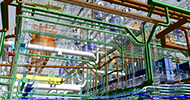Manufacturers today are under immense pressure. With tightening margins and increasingly stringent quality standards, staying competitive requires a strategic rethink of business operations. For many, this has led to a data-driven transformation of their service strategies, shifting toward proactive maintenance as a key driver of efficiency and resilience.
This blog explores the trends shaping this shift, unpacks the benefits of proactive maintenance, and offers practical steps to assess and evolve your approach.
The data behind the shift
The shift toward proactive maintenance is rooted in compelling data that underscores its impact across the manufacturing industry. Consider these benchmarks:
- 30–50% reduction in unplanned downtime: Proactively maintaining equipment significantly cuts costly disruptions by addressing issues before they escalate.
- 10–40% decrease in maintenance costs: Optimised maintenance schedules reduce unnecessary repairs while preventing expensive emergency fixes.
- 20% boost in Overall Equipment Effectiveness (OEE): Efficient, well-maintained equipment performs better, contributing directly to production efficiency.
- 5% drop in quality-related defects: Proactive measures ensure equipment produces consistent, high-quality outputs, reducing defects.
- 18% reduction in quality costs compared to industry averages: With fewer quality issues, manufacturers save on rework, recalls, and waste.
These numbers represent more than just isolated success stories; they reflect an industry-wide benchmark for adopting proactive maintenance, revealing a clear pathway to operational excellence.
What proactive maintenance actually looks like
To understand proactive maintenance, it helps to contrast it with reactive maintenance. While reactive maintenance addresses issues after they occur, proactive maintenance predicts and prevents problems before they disrupt operations.
Here are key examples of proactive maintenance in action:
- Scheduled calibrations and checkups: Performing regular inspections ensures that equipment continues to operate within manufacturing specifications.
- Planned service during production downtime: Maintenance is scheduled around your plant’s downtime, minimising disruption and keeping productivity high.
- Real-time monitoring with Metrology Asset Manager and Pulse: Track measurement activity, utilisation, and environmental conditions like temperature in real time to help identify potential issues early—before they affect performance.
By focusing on preventing downtime and addressing performance issues early, proactive maintenance transforms maintenance from a reactive necessity into a strategic advantage.
Real-world impacts
The benefits of proactive maintenance extend far beyond the maintenance team, driving improvements across the entire operation. Here’s how it can make a tangible difference:
- Smoother production planning: With fewer unexpected breakdowns, manufacturers can better align production schedules and delivery timelines.
- Higher-quality output: Well-maintained equipment consistently produces better results, reducing rework and waste.
- More informed decision-making: Proactive strategies often include questioning the data—not just collecting it. By identifying anomalies, challenging assumptions, and validating performance metrics, teams can uncover hidden issues before they escalate.
- Lower total cost of ownership (TCO): A proactive approach extends the life span of equipment, protecting capital investments and reducing lifetime costs.
- Greater operational resilience: Proactive maintenance equips manufacturers to weather disruptions in the supply chain or workforce, ensuring continuity.
These benefits aren’t just theoretical. Leading manufacturers across various sectors report measurable improvements in efficiency, quality, and resilience once proactive maintenance is in place.
Benchmarking your approach
Curious about how your current maintenance strategy stacks up? Here’s a self-assessment to help you identify areas of improvement:
- Do you track unplanned downtime and its costs?
- Are your service costs consistent and predictable?
- When was the last time your equipment’s calibration intervals were evaluated?
- Are quality defects or inefficiencies sometimes traced back to equipment conditions?
If you find room for improvement in your answers, it may be time to rethink your maintenance strategy and align with best practices in proactive maintenance.
Evolving toward resilience
There’s no “one-size-fits-all” solution to maintenance. Proactive maintenance strategies can and should be tailored to the unique needs of your operation. The common thread, however, is thinking ahead and using data to make informed, proactive decisions.
Manufacturers adopting proactive maintenance are not merely reacting to challenges; they’re positioning themselves for long-term resilience and profitability. By benchmarking your approach and considering the broader industry trends, you can join the ranks of organisations that are turning maintenance into a competitive advantage.
Looking to build resilience into your operations? Contact us to explore efficiency benchmarks and discover actionable insights tailored to your sector.














